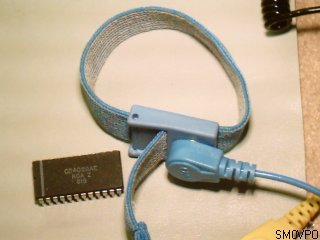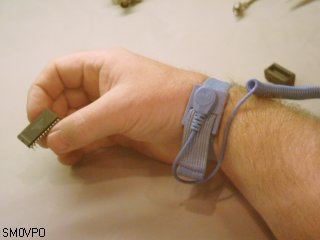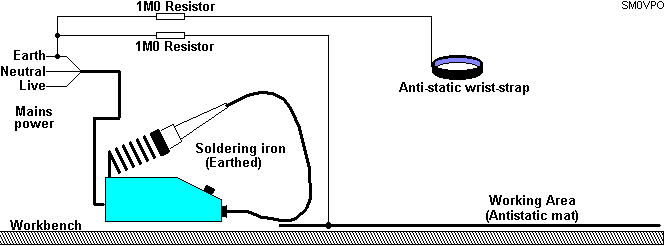

Everyone has heard of static electricity, but surprisingly not so many people actually understand just how harmful it can be to delicate electronic circuits. Popular myths can also lead to dangerous practices in an attempt to protect homebrew equipment from the harmful effects of static electrical discharges. I must confess that I used to be quite laxadasical when it came to static electricity, but I learned my lesson a few years ago.
In this article I hope to clarify a few points and perhaps help you to prevent damage to your expensive components, and most of all, prevent physical harm to you, the constructor. I will also show you how to build your own static-discharge protected workbench.

Just over 200 years ago, the term "Static Electricity" was not invented. Effects were noticed by accident, effects such as generating a "standing charge" on an amber rod, by rubbing it with a bit of cloth. Indeed, it was a rather "neat" party trick to attract small items by this newly discovered magical property of amber.
According to the laws of conservation of energy, energy cannot be created or destroyed - it can only be changed from one form to another. When you apply a charge to your cellular telephone battery, the energy is stored in the cell. When the cell is full and cannot hold more, the energy is converted to heat: a sure sign that the cell is fully charged. So if you apply energy, it will always go somewhere.
When you apply friction (energy) to an amber rod, electrons are dragged about and moved into places they would not otherwise be found. This electron displacement results in an electrical pressure, or voltage. To dissipate this energy we would need a conductor to allow the electrons to return to a position of equilibrium. Without the conductor, then the electrons are going nowhere and the charge will stay put - static.

Big!
It can vary widely from just a few tens of volts, to many thousands of volts. A lot depends upon what sort of material is used to generate the charge. Skin and hair are quite close, which is why stroking the cat does not usually electrocute the cat, but there are times when doing just that can generate small sparks of just a couple of thousand volts. For comparison, here is a rough chart showing a selected few materials listed in the "Triboelectric Series":

As you can see, skin and nylon are seperated in the scale. This is bad new for the manufacturers of delicate electronic components who use women on the production line. Wallace Caruthers developed nylon, which rapidly became used as a substitute for silk. Skin and nylon were soon to generate huge voltages that would cause high failure rates in the new generation of electronic components.


Nick de Smith has also informed me that when he did his EE degree at Southampton Uni (76-80), he was given a story by a lecturer on ESD and nurses: Aparently, in the early days of nylons and& using Nitrous Oxide (NO2) as an anaesthetic, there was a spate of exploding patients, or rather their chest cavities exploded when nurses touched them - NO2/O2 is an explosive mixture. Since then, all operating theatre staff must wear natural fibres, including underwear, to cut down on PLODs (Patients Lost through Detonation).
Nylon was invented in about 1940, but at that time we were still using vacuum tubes, or valves. These could easily withstand 100,000 volt static discharges. In the 1950s we saw the germanium transistor. These could withstand low current discharges, but voltages of up to 1000 would not always kill them. Today we have Metal Oxide Silicon Field Effect Transistors (MOSFETs), which can be destroyed by a voltage of less than 10 volts.
The first commercially available logic chips were Transistor-Transistor Logic (TTL). Whilst having an operating voltage of only 5 volts, the outputs can sink up to 100mA of current, and input logic levels are higher than 1mA. This means that the odd 150 volts of static may only tickle them a little, but the later generation of low-current devices use a pair of Field-Effect transistors in a complementary output stage: Complementary Metal Oxide Silicon (CMOS). If you are actively seeking weak VHF signals, then will no-doubt have come across Galium Arsenide Field Effect Transistors (GaAsFETs). GaAsFETs are probably todays most static-sensitive electronic component.
CMOS logic circuits can be damaged with just a few tens of volts, but today most of them are protected by diodes connected between inputs and the power supply rails. The protected devices usually have a "B" suffix in the device name, eg. CD4046B. Some devices may need to operate without this diode protection, in which case the device suffix becomes "UB", eg. CD4049UB.

Yes!. Put four jam-jars in the oven at 100 degrees C for an hour. Place the jars upside-down on the floor in front of your colour TV set. Switch on the TV and stand on the jars, then touch the TV screen with the flat of your hand. Gently draw your hand over the whole surface of the screen. Now reach out and touch the cat.

Notice how both you and the cat reacted. That spark leapt a good 2 inches. The voltage was around 50,000 volts, perhaps more with older colour TV sets. A spark can leap over a gap of typically 1mm for every 1000 volts. The charge you just applied to the cat was stored in a massive conductor - your body! If it hurt a little, then be grateful that your mass is probably smaller than my own 98Kg! This same principle was used in the 19th century, but lead balls were placed inside the jam-jars. The glass jars were called "Leyden Jars". This "scientific apparatus" was also referred to as a "condenser", because many people thought of electricity as fluid that could be condensed. Today we would call it a "capacitor".
These jars were often charged by means of a variety of instruments, such as a "Vandengraaf Generator", or kites flown during thunder storms, but PLEASE do NOT try that for yourself. You could get yourself seriously killed, and I would get yet more e-mail.

You can protect your own components by taking a series of precautions. For example, I never wear nylon stockings when I am handling static sensitive components :-). But seriously, you should always ensure that anything that comes in contact with a sensitive component is at the same DC potential as the component. Damage only occurs when current flows through a sensitive device, and if everything is at the same potential then there will be no current flow. After all, birds are not electrocuted when they sit on a 135,000 volts power line.


Here you can see my anti-static wrist-strap, but in the background you see my anti-static mat on the workbench, the 1M0 connector is in the yellow stud connection. The wrist-band has a 1M0 resistor in the blue stud connection. If you are contemplating doing much work with CMOS or MOSFET devices, then it is well worth the effort of setting up a decent anti-static workbench. It should be wired something like this:


A normal healthy person can withstand quite heavy currents through the body. 10mA is usually considered fatal, but even 1mA can be regarded as a "severe reprimand". 1mA can start a heart attack if one has a weak heart. Under normal circumstances, no item in a home or workshop will accumulate much of a charge. Perhaps nylon clothing, carpets can induce a charge big enough to be noticed, but it is not so common. Remember that lightning is just a huge static charge. It is so large due to the prolonged accumulation of the charge, and the sheer physical size of the conductor storing it.
Many people believe that you can lay a bit of aluminium foil on the workbench and connect it to ground, along with the soldering iron and everything else in sight. Yes you can do this, BUT it must be connected to ground via a 1M0 resistor (brown-black-green). If not, then should you be in contact with the foil and you touch a live wire, then you will suffer a higher current-flow to ground through your body. According to Ohms law, current is directly proportional to the applied voltage, but in opposite proportion to the resistance of the conductor. The resistor therefore reduces the current to a safe level. One million Ohms is the usual value accepted for the electronic workbench.
When working on equipment involving high voltages and capacitors, it is common practice to have a "De-Bollocking Stick", which consists of a long insulated stick with a metal hook at the end. The hook is connected to a wire via a 10K resistor, and the end of the wire is grounded. When the hook is touched onto a capacitor terminal, from a distance, the capacitor will become safely discharged. If the voltage is high enough then there may be a loud bang, but not with normal amateur equipment. One of the few household equipments that can store a lethal charge is a microwave oven.

I used to work on 50,000-watt HF transmitters in the military. The transmitters had 3 "cabins", each of which you could walk inside. The PSU cabin had a transformer on wheels that could be wheeled out of the cabin on rails, but of course we had to "de-bollock" the capacitors before entering the cabin.
